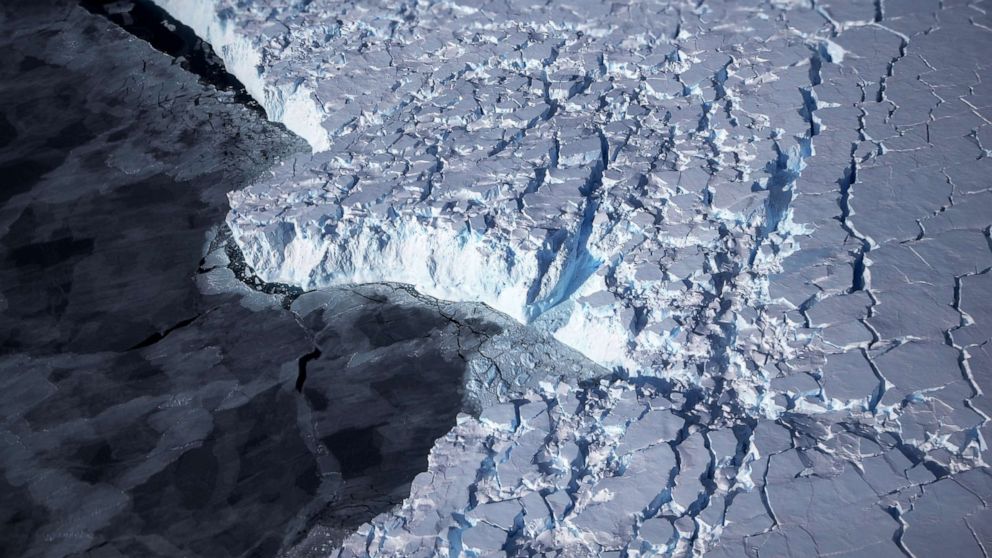


Satellite imagery over Antarctica shows the rapid deterioration of two glaciers -- the most watched by climate scientists -- over recent decades, which could indicate rising sea levels globally.
The Pine Island and Thwaites glaciers, located in the Amundsen Sea in West Antarctica, are among the fastest changing glaciers in the region; they're responsible for the largest contribution to sea level rise that's coming from Antarctica. Damage observed in the side-by-side glaciers show highly crevassed areas and open fractures -- both signs that the shear zones on both glaciers, where the ice shelf is thin, have weakened structurally over the past decade, according to a new study published in the Proceedings of the National Academy of Sciences on Monday by the Delft University of Technology in Denmark.
Thwaites is one of the fastest-flowing glaciers in Antarctica and would be the structure responsible should something in the West Antarctic destabilize, Indrani Das, associate research professor at Columbia University's Lamont-Doherty Earth Observatory and co-principle investigator for a project at the International Thwaites Glacier Collaboration, told ABC News. Overall sea levels are rising about 3.5 millimeters a year, and Thwaites alone contributes about 4% or 5% of that, Brent Goehring, associate professor of earth and environmental sciences at Tulane University and lead principle researcher on the International Thwaites Glacier Collaboration, told ABC News.
"Thwaites Glacier is often referred to as the weak underbelly of the West Antarctic ice sheet," Goehring said.
MORE: Dramatic images show ice-less region of Antarctica following record-high temperatures"If those glaciers would destabilize, a lot of neighboring areas would also fall apart, causing a widespread collapse," Das said. "It would cause a huge sea level rise."
The new study used satellite images from multiple sources as well as models to assess how much and how fast both of the glaciers will weaken if the current rate of evolution continues. However, projecting the future of the glaciers remains a "major uncertainty," the study states.
Both glaciers show distinct changes in recent decades driven by changes in atmospheric and ocean conditions that have caused melting of their floating ice shelves. Both glaciers have experienced accelerated thinning as a result.
The ice shelves essentially act as buttresses to the glaciers, similar to how the buttressing on the Notre Dame Cathedral in Paris extend off the main structure to hold it up, Goehring said. Images taken in 1997 show a lack of crevasses in the same area, according to the study. The images also show that the initial damage is now expanding "rapidly."
MORE: Greenland ice sheet melting could expose 400 million people to flooding by end of century, study saysNew damage to the ice shelf then triggers a feedback process, which then speeds up and weakens the damage in the sheer zones, according to the study. This process is generally not accounted for in current ice sheet models looking at how to slow sea level rise.
Researchers believe the feedback process has resulted in the ice shelves being preconditioned for further disintegration and large calving events (i.e., when a large piece breaks off), similar to occurrences in October 2018 and February 2020, in which an "unprecedented retreat" of the ice shelf occurs.
Although the potential for such a collapse could be restricted due to limited melting on the surface, the damage makes the future response of the glaciers' ice shelves more sensitive to extreme climate change in the ocean, atmosphere and sea ice, according to the study. Most of the melting is going on under the surface, where the ocean water is warm, Goehring said. But, the crevassing on the surface adds another layer of concern and would speed up the disintegration of the glaciers "even more," Das said.
Scientists have come to understand in the last few years how "vastly important" fractures and cracks in the ice shelves are to the melting process, Goehring said. Researchers are performing extensive mapping via air, ground, ocean, satellite and models to do so, Das said.
MORE: What to know about the rapid melting of the Greenland ice sheet, a significant contributor to rising sea levels"We’re moving as fast as we can to understand how much and how fast" the damage is occurring as well as every possible mode of melting, Goehring said.
However, Das cautioned that a widespread collapse would likely not happen in this century, despite the rapid changing.
"We are monitoring it, but still there is so many important questions that are remaining to be answered," she said.